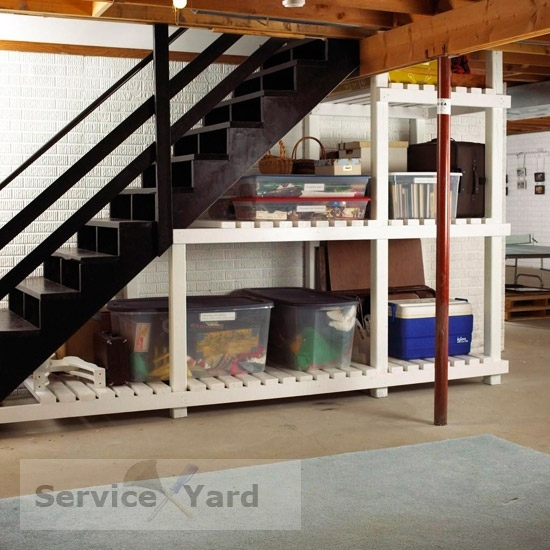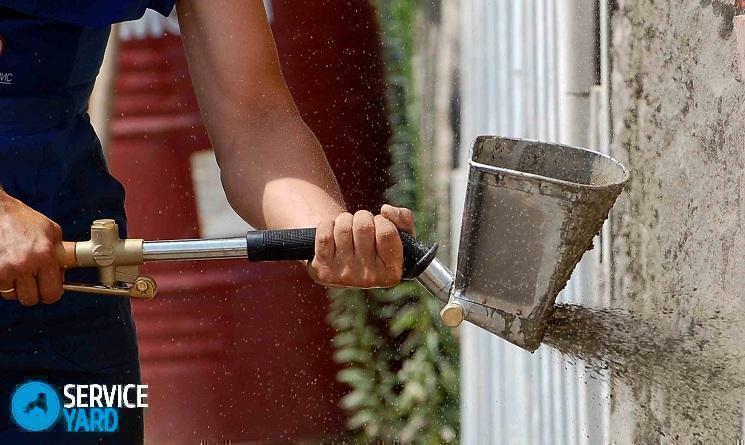
- Why does the basement have mold?
- What is mold?
- Methods of prevention of mold development
- The main types of mold, which is found most often in cellars and cellars:
- How to deal with mold in the basement of the house?
Mold in the basement is a common problem, but do not close your eyes to it. This is not only a cosmetic defect in the room, but also a risk of destruction of walls plus a big threat to your health. Considering such factors, once you notice the first signs of the defeat of corners or walls by fungi, immediately ask yourself how to deal with mold in the basement of the house and proceed to action immediately.
to the contents ↑Why is there a mold in the basement?
The main reasons for the appearance of mold in the basement are poor air ventilation and poor-quality waterproofing of the room from close-lying groundwater.
to the contents ↑What is mold?
 Mold is a kind of fungus that reproduces very quickly and has great viability. The increased humidity in the basement induces the appearance of dampness, air stench. This environment is most favorable for the birth and intensive development of mold. Therefore, it turns out that the mold in the basement has become a familiar phenomenon for many.
Mold is a kind of fungus that reproduces very quickly and has great viability. The increased humidity in the basement induces the appearance of dampness, air stench. This environment is most favorable for the birth and intensive development of mold. Therefore, it turns out that the mold in the basement has become a familiar phenomenon for many.
Mold spores produce toxins. Through the air, spores are spread over large enough distances. Hence, even if their source is deep in the basement, this does not give you any guarantees of safety from them in the apartment, even on the uppermost floor and, moreover, in rooms in a private house.
Important! Mold spores provoke a decrease in immunity in people, rashes on the skin, allergies, and also can cause more serious diseases right up to the oncology. That is why you must know how to fight mold in the basement, and take appropriate measures in a timely manner.
to the table of contents ↑Methods of prevention of mold development
It is not so easy to get rid of this fungus. Simply removing mold from walls and ceiling absolutely will not lead to anything, since it is not only on the surface of buildings, but is ingested deep inside. The earlier you start fighting with him, the more effective the result will be. It is even better to do preventive work in the basement to prevent the appearance of this unpleasant phenomenon.
Ventilation
In the basement, in order to avoid mold generation, it is necessary to ensure good air circulation. To do this, it is sufficient to install two ventilation pipes: one in the ceiling, the other on the opposite wall, at a height of about 20 cm from the floor. If natural ventilation is difficult to do, then create an artificial one by installing a chimney with a fan.
Important! If a high level of groundwater becomes the cause of dampness in the basement, it is necessary to make waterproofing construction work and to eliminate the threat of increased humidity.
Airing
In summer warm time, open the basement to ventilate it well and dry it. Perform a number of additional actions:
- Get all the structures and parts from the basement.
- Wooden shelves wash and dry well in the sun, cover with antiseptic.
- Metal products clean from rust and color.
Means for the prevention of fungus:
- Whiten the walls and ceiling of the cellar or cellar with a solution of lime and copper sulphate. It is prepared in such proportions: 2 kg of freshly lime, 200 g of vitriol and 40 liters of water.
- Hang the branches of mountain ash on the walls and place them on shelves, barrels with pickles, raw vegetables.
- Place a box of quicklime in the basement. This helps to get rid of excessive moisture in the room.
Important! By doing such simple activities, you can quickly remove the mold in the basement, and henceforth it will appear less often and in a smaller amount.
to content ↑The main types of mold that are found most often in cellars and cellars:
- Mold stains of black, brown, green or blue color most often affect concrete, stone structures and surfaces treated with poor-quality paint. This type of mold can provoke complete damage to the finish.
- Blue mold is the main "enemy" of wooden buildings. It causes damage and decay of the tree.
- White mold is particularly dangerous in that it moves quickly and spreads to neighboring rooms.
How to deal with mold in the basement of the house?
 Before dealing with mold in the basement, you need to prepare for yourself such protective equipment:
Before dealing with mold in the basement, you need to prepare for yourself such protective equipment:
- Respirator
- Gloves
- Overalls that protect you from aggressive chemicals.
Important! Be careful when handling mold. Do not touch the fungus with your bare hands and do not let mildew hit unprotected skin. It has the property of rapid absorption through the skin.
Effective means for mold control
If the mold has only just begun to appear, then the whole room does not need treatment. You can simply apply to the problem areas with a cotton pad, or rags, table vinegar, hydrogen peroxide, or vodka.
The recipes for treatment with such solutions are also tested in practice:
- 1 part of copper sulfate, 1 part of clay and 10 parts of water.
- Chlorinated mixtures. You can use ordinary whiteness. The solution makes a strong concentration;
- 100 g of vitriol per 1 liter of water.
- Equal parts of bleach, slaked lime and water.
- A solution of white spirit and salicylic acid in 2: 1 proportions.
- 950 g of table salt, 50 g of boric acid, dilute in 5 liters of boiling water. This treatment is repeated at least 5 times.
- 10 liters of water and 250 ml of 40% formalin.
- Mold is very susceptible to acids. Therefore, it can be treated with a solution of citric, boric acid. Alternatively, hydrochloric acid can be used.
Important! When using hydrochloric acid, always wear thick rubber gloves and dense protective clothing to avoid chemical burns.
Finishing:
- Treat one of these solutions with moldy areas of walls, floor, ceiling.
- After drying, plaster and whitewashed areas. With good air circulation mold will no longer appear.
- Seal the entire basement - plug all holes and ventilation ducts.
- Place a piece of sulfur with a calculation of 40-50g per 1m3 of space in any metal or ceramic dishes. Catch sulfur, quickly exit and close the cellar tightly.
- You can also use the finished sulfur bead. Do not open the basement for at least 10 hours. After that, ventilate it well and dry it.
Important! When using this method, one must be very careful, since the gas released during combustion is very toxic. Use a protective suit and a gas mask.
Mold in the basement is a serious problem that needs to be addressed urgently. Do not postpone this matter "for later".The earlier you notice the mold, the easier it will be to get rid of this harmful fungus.



